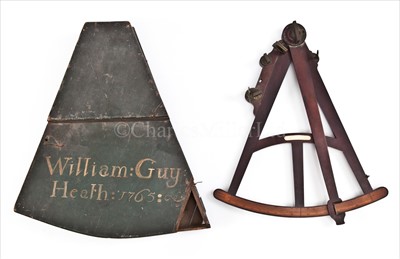26th Oct, 2011 12:00
Maritime and Scientific Models, Instruments & Art (Implacable)
188
[M] A FINE 18IN. RADIUS MAHOGANY AND BOXWOOD...
the boxwood arc divided 0-90º in both directions and signed at left B: Martin * LONDON, mahogany index arm with fiducial reader, clamp, arm stop on right of frame, two pin hole sights, three interchangeable shades, mirrors and wooden rests behind, contained within original fitted painted keystone case with remnant hooks and inscribed William : Guy : Heath : 1765 :' -- 22 x 19in. (56 x 48cm.)
One officer simply listed as 'William Heath' served in the Royal Navy close to the date inscribed on the case. He was made a lieutenant in 1775, retired in 1807 and died in 1815. As Martin had long since stopped making this pattern by 1765 (the Vernier scale being commonly fitted by then), it is plausible that it was bought second hand for Heath when a young midshipman and would explain the childish, over-sized inscription on the lid. This instrument, which appears to be complete and long untouched, was recently discovered in a vintage suitcase.
Benjamin Martin (1714-82) initially worked in Chichester (1738-40) but spent the majority of his life around Crane Court off Fleet Street, London where he sold a full range of instruments, but specialised in Hadley's quadrant or octant as they were generally known, writing several papers over the years. One of his compasses went with Captain Cook on his third voyage and another of his quadrants resides at Greenwich (NAV1254). He apprenticed and employed some notable future makers, not least Gabriel Wright and William Jones. In 1780 he took his son Joshua Lover Martin into a partnership that ended almost immediately with the firm's bankruptcy. Two years later he died and his tools were acquired by Charles Tulley.
Sold for £4,712
Estimated at £1,500 - £2,500
(inc. buyer's premium of 24%)
Condition Report
The octant is in excellent, untouched condition - the interchangeable shades will need some gentle encouragement as seized in place, the bottom of the index arm has a split from the edge to the screw holding clamp insitu. The box shows age - lid detached and keystone has separated, bottom right corner of lid missing and has evidence of old worm damage, case is complete by has old losses along bottom edge where the index arm comes into contact and bottom right joint slightly sprung, the steel hooks are missing their heads, but overall box is complete, strong and highly restorable.
We are pleased to provide you with a general report of the condition of this property. Since we are not professional conservators or restorers, we urge you to consult with a restorer or conservator of your choice who will be better able to provide a detailed, professional report. Prospective buyers should inspect each lot to satisfy themselves as to condition and must understand that any statement made by Charles Miller Ltd is merely a subjective, qualified opinion. Prospective buyers should also refer to any Important Notices regarding this sale, which are printed in the Sale Catalogue. NOTWITHSTANDING THIS REPORT OR ANY DISCUSSIONS CONCERNING A LOT, ALL LOTS ARE OFFERED AND SOLD “AS IS” IN ACCORDANCE WITH THE CONDITIONS OF BUSINESS PRINTED IN THE SALE CATALOGUE.
the boxwood arc divided 0-90º in both directions and signed at left B: Martin * LONDON, mahogany index arm with fiducial reader, clamp, arm stop on right of frame, two pin hole sights, three interchangeable shades, mirrors and wooden rests behind, contained within original fitted painted keystone case with remnant hooks and inscribed William : Guy : Heath : 1765 :' -- 22 x 19in. (56 x 48cm.)
One officer simply listed as 'William Heath' served in the Royal Navy close to the date inscribed on the case. He was made a lieutenant in 1775, retired in 1807 and died in 1815. As Martin had long since stopped making this pattern by 1765 (the Vernier scale being commonly fitted by then), it is plausible that it was bought second hand for Heath when a young midshipman and would explain the childish, over-sized inscription on the lid. This instrument, which appears to be complete and long untouched, was recently discovered in a vintage suitcase.
Benjamin Martin (1714-82) initially worked in Chichester (1738-40) but spent the majority of his life around Crane Court off Fleet Street, London where he sold a full range of instruments, but specialised in Hadley's quadrant or octant as they were generally known, writing several papers over the years. One of his compasses went with Captain Cook on his third voyage and another of his quadrants resides at Greenwich (NAV1254). He apprenticed and employed some notable future makers, not least Gabriel Wright and William Jones. In 1780 he took his son Joshua Lover Martin into a partnership that ended almost immediately with the firm's bankruptcy. Two years later he died and his tools were acquired by Charles Tulley.
Auction: Maritime and Scientific Models, Instruments & Art (Implacable), 26th Oct, 2011


















